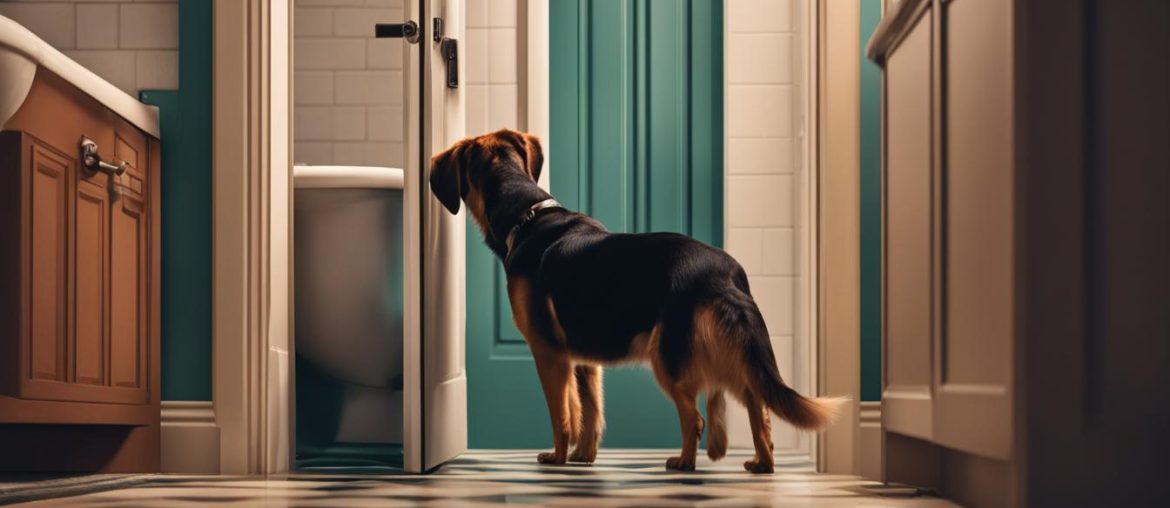Have you ever wondered why your furry friend insists on following you to the bathroom? It’s a behavior that many dog owners experience, and it’s rooted in their instinctual nature and strong pack mentality.
Dogs are known for their loyalty, and they have a strong desire to be close to their owners at all times. This behavior, often referred to as “Velcro dogs,” is their way of protecting their pack and alleviating any feelings of vulnerability when you’re out of their sight.
Key Takeaways:
- Dogs follow their owners to the bathroom due to their instinctual nature and pack mentality.
- This behavior is a sign of their strong desire to protect their pack and avoid feelings of vulnerability.
- Positive reinforcement and curiosity are also factors that contribute to this behavior.
- Understanding and respecting your dog’s needs can help foster a stronger bond between you and your canine companion.
- Seek professional help if you encounter any concerning or challenging behaviors in your dog.
Reasons Dogs Follow You to the Bathroom
There are several reasons why dogs follow their owners to the bathroom. One possible explanation is the positive reinforcement they receive. If dogs associate being with their owners in the bathroom with affection or treats, they are likely to continue following this routine. Dogs are highly motivated by rewards and will repeat behaviors that lead to favorable outcomes.
Another reason dogs may follow you to the bathroom is curiosity. Dogs see their owners as a gateway to all things wonderful and magical, and they want to be a part of everything their owners do. Exploring new environments and observing their owners’ actions can be an exciting and enriching experience for dogs.
In addition, dogs may view the bathroom as a part of their home territory and feel the need to monitor their owners’ whereabouts within these boundaries. Dogs have a natural instinct to protect their pack, and by following their owners to the bathroom, they can ensure their owners’ safety and maintain a sense of security for themselves.
“Dogs are highly motivated by rewards and will repeat behaviors that lead to favorable outcomes.”
| Reasons Dogs Follow You to the Bathroom | Description |
|---|---|
| Positive Reinforcement | If dogs associate being with their owners in the bathroom with affection or treats, they are likely to continue following this routine. |
| Curiosity | Dogs see their owners as a gateway to all things wonderful and magical, and they want to be a part of everything their owners do. |
| Bathroom as Territory | Dogs may view the bathroom as a part of their home territory and feel the need to monitor their owners’ whereabouts within these boundaries. |
Understanding these reasons can help dog owners appreciate their canine companions’ behavior and strengthen their bond. By providing positive reinforcement, engaging in interactive play, and ensuring a safe and secure environment, owners can create a harmonious relationship that meets both their own and their dog’s needs.
Canine Bathroom Bonding and Attachment
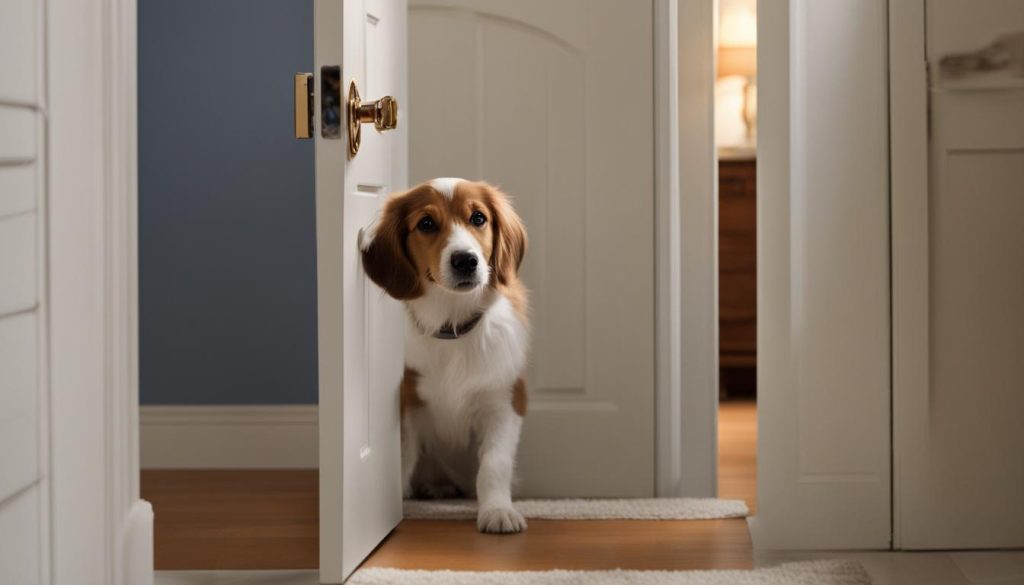
Dogs view their owners as their primary source of love, comfort, and security. By following their owners to the bathroom, they are displaying their attachment and bonding to them. Dogs feel secure and safe when they are close to their owners and may find comfort in their presence. This behavior also stems from their pack mentality, as they see their owners as the leaders of their pack and want to be near them at all times.
The Importance of Dog Bathroom Bonding
When dogs follow their owners to the bathroom, it is an opportunity for them to strengthen their bond. Dogs are highly social creatures, and they seek companionship and connection with their owners. By being present during personal moments, dogs show their trust and loyalty, deepening the emotional connection they have with their owners.
Dogs are naturally curious beings, and the bathroom is often a fascinating place for them. They are intrigued by the smells, sounds, and activities that take place in this private area. Following their owners to the bathroom allows dogs to satisfy their curiosity and explore different aspects of their human’s daily routines.
“Dogs view their owners as their primary source of love, comfort, and security.”
Understanding Dog Bathroom Habits
Each dog may have its own specific reasons for following their owners to the bathroom. Some dogs may do it out of anxiety or a fear of being left alone. They feel more at ease when they can observe their owners and ensure their presence.
Additionally, dogs are creatures of habit, and routines play a significant role in their lives. If following their owners to the bathroom becomes a regular part of their daily routine, they may continue doing so out of habit and the comfort it brings them.
Building a Strong Dog-Owner Relationship
Allowing dogs to accompany their owners to the bathroom can be a positive way to strengthen the bond between dog and owner. It provides an opportunity for the dog to feel close to their owner and reinforces the trust and love they share.
However, it’s essential to set boundaries and establish clear expectations. If the behavior becomes intrusive or disruptive, owners can gently discourage it by redirecting their dogs’ attention or providing alternative activities or toys.
| Benefits of Dog Bathroom Bonding | Tips for Encouraging Positive Behavior |
|---|---|
| Strengthens the bond between dog and owner | Establish consistent routines |
| Provides comfort and security for the dog | Set clear boundaries and expectations |
| Satisfies the dog’s curiosity about their owner’s activities | Redirect attention to alternative activities or toys |
Ultimately, understanding the reasons behind dogs following their owners to the bathroom can help foster a deeper connection and promote a harmonious relationship between dog and owner.
Animal Instinct and Pack Mentality
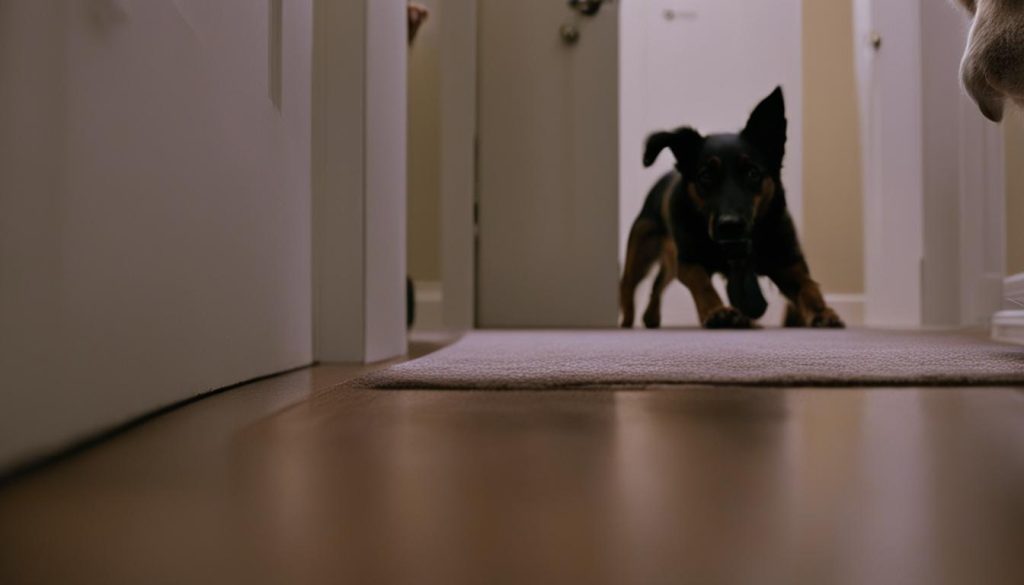
Dogs have a deep-rooted animal instinct and a strong pack mentality that influences their behavior. When dogs follow their owners to the bathroom, it is a reflection of their pack mentality and their desire to be close to their pack leader.
Dogs perceive their owners as the leaders of their pack, and they have a natural instinct to protect and be near them at all times. By following their owners to the bathroom, dogs are exhibiting their loyalty and their need to keep their pack intact.
This behavior is often seen in dogs who are referred to as “Velcro dogs.” These dogs have a heightened desire to be close to their owners and may exhibit clingy behavior in various situations, including following them to the bathroom.
The Pack Mentality in Dogs
Dogs are descendants of wolves, who are highly social animals that live in packs. Like their wolf ancestors, dogs have a strong instinct to be part of a group and to always stay close to their pack members.
“A dog is the only thing on earth that loves you more than he loves himself.” – Josh Billings
Following their owners to the bathroom is just one way dogs display their pack mentality. They seek comfort and security in being near their pack leader and view their owners as an important part of their social group.
Understanding and Embracing Your Dog’s Pack Mentality
It is crucial for dog owners to recognize and appreciate their dog’s pack mentality. By understanding that your dog follows you to the bathroom out of a natural instinct and a desire for companionship, you can foster a stronger bond with your furry friend.
Providing your dog with love, attention, and a sense of security is essential in addressing their pack mentality. Engaging in regular exercise, training, and playtime can help fulfill your dog’s social and physical needs, reducing their need to follow you constantly, including to the bathroom.
Dog Affection and Attention
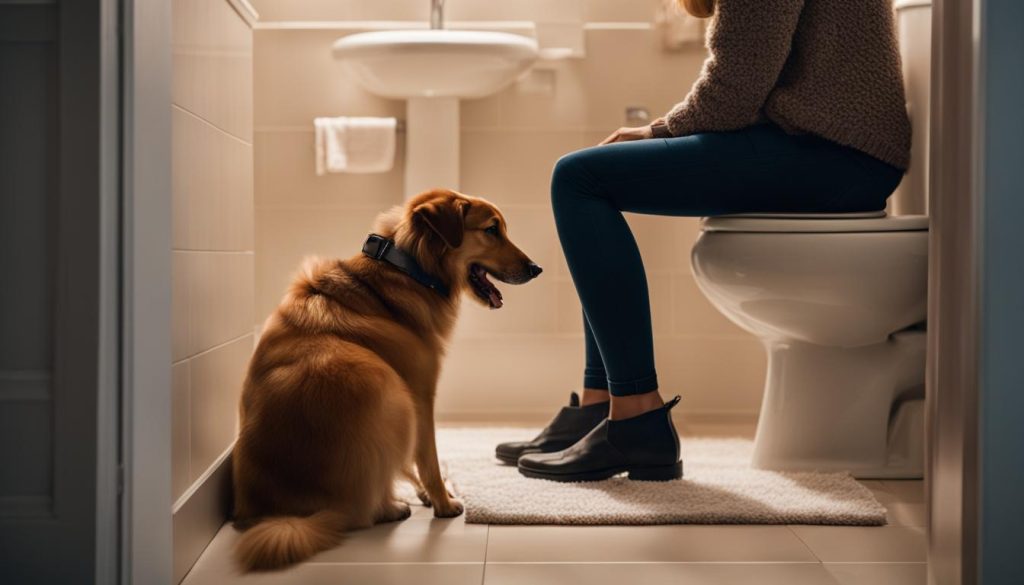
Dogs are known for their unwavering loyalty and affection towards their owners. They thrive on human interaction and crave attention from their beloved companions. Following their owners to the bathroom is one way dogs seek affection and attention, as it allows them to be in close proximity and engage in a shared experience.
“My dog always follows me to the bathroom. I think she just wants some extra love and attention,” says dog owner, Sarah.
“Whenever I close the bathroom door, she scratches at it and whines. I can tell she just wants to be with me and doesn’t like being separated.”
This behavior is especially common in dogs who have formed strong bonds with their owners and rely on them for emotional support. Dogs view their owners as the center of their world and seek comfort in their presence. Following their owners to the bathroom is a way for dogs to express their love and devotion while also satisfying their need for attention.
It is important for dog owners to provide their furry friends with ample affection and attention throughout the day, not just when they follow them to the bathroom. Regular playtime, cuddles, and positive reinforcement can help fulfill a dog’s emotional needs and strengthen the bond between owner and pet.
Common Dog Behavior
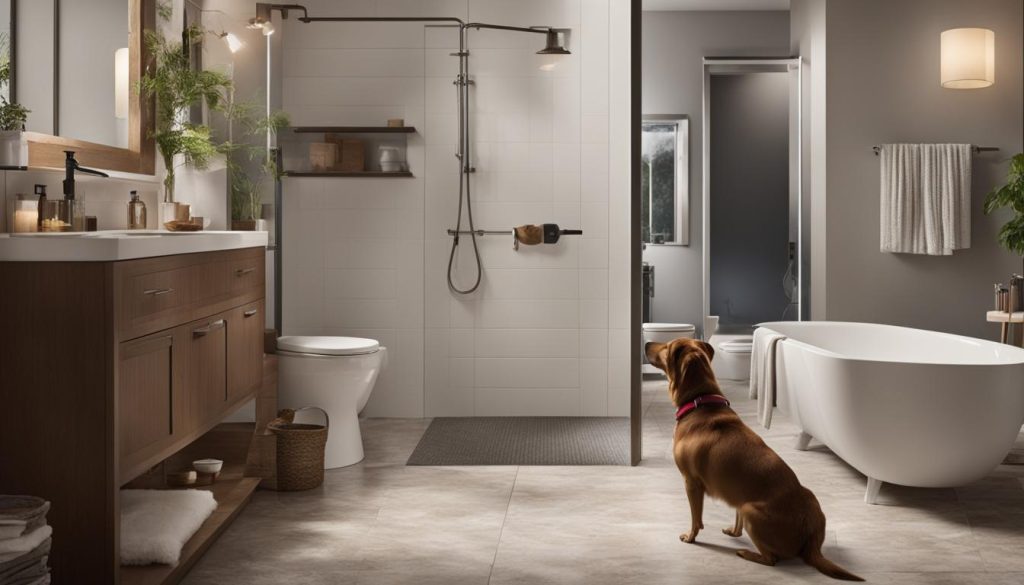
Understanding common dog behavior is essential for pet owners to develop a deeper bond with their furry companions. Dogs exhibit a wide range of behaviors, some of which may seem peculiar to humans. One such behavior is the tendency to follow their owners to the bathroom. While it may appear strange, this behavior is quite common among dogs and can be attributed to their innate instinct and desire for companionship.
When dogs follow their owners to the bathroom, it is a display of their attachment and the strength of their bond. Dogs are social animals and view their owners as part of their pack. They want to be near their pack leaders, seeking comfort, security, and protection. Following their owners to the bathroom allows dogs to stay close and alleviate any feelings of vulnerability when their owners are out of sight.
This behavior is also a reflection of dogs’ pack mentality. Dogs have an instinctual need to be part of a group, and they see their owners as an integral part of their pack. By following their owners to the bathroom, dogs demonstrate their pack mentality and their natural desire to protect and be close to their pack members.
In summary, dogs following their owners to the bathroom is a common behavior that stems from their natural instincts, pack mentality, and attachment to their owners. It is important for dog owners to understand and appreciate these behaviors as a part of their furry friend’s nature. By nurturing this bond and providing the attention and care dogs need, owners can strengthen their relationship and create a harmonious living environment for both themselves and their loyal companions.
Factors Influencing Dog Behavior
Several factors can influence a dog’s behavior, including changes in their environment, health, and emotional state. Understanding these factors is crucial for dog owners to address any behavioral changes and ensure the overall well-being of their pets.
Environmental Changes
Dogs are sensitive to their surroundings, and any significant changes in their environment can affect their behavior. Moving to a new home, introducing new people or pets, or even rearranging furniture can cause dogs to feel anxious or insecure. These changes may lead to behaviors such as increased clinginess or following their owners to the bathroom as a way to seek comfort and reassurance.
Health and Physical Condition
A dog’s behavior can also be influenced by their physical well-being. Illness, pain, or discomfort can lead to changes in behavior, including increased dependence on their owners. Dogs may follow their owners to the bathroom as they seek support and companionship during challenging times. It is essential for dog owners to regularly monitor their pet’s health and consult a veterinarian if they notice any unusual behavior.
Emotional State and Insecurity
Dogs, like humans, can experience emotional ups and downs. Changes in routine, separation anxiety, or traumatic experiences can impact a dog’s emotional state and manifest in their behavior. Insecurity can be a driving factor for dogs to display clingy behaviors, such as following their owners to the bathroom. Providing a stable and secure environment, along with positive reinforcement, can help alleviate their insecurity and promote more confident behavior.
| Factors Influencing Dog Behavior | Examples |
|---|---|
| Environmental Changes | Moving to a new home, introducing new people or pets |
| Health and Physical Condition | Illness, pain, discomfort |
| Emotional State and Insecurity | Changes in routine, separation anxiety, traumatic experiences |
Table: Factors Influencing Dog Behavior
In conclusion, several factors can influence a dog’s behavior, including environmental changes, health conditions, and emotional well-being. By understanding these factors, dog owners can better address any behavioral changes and provide the necessary support and care for their furry companions.
Addressing Unwanted Behavior
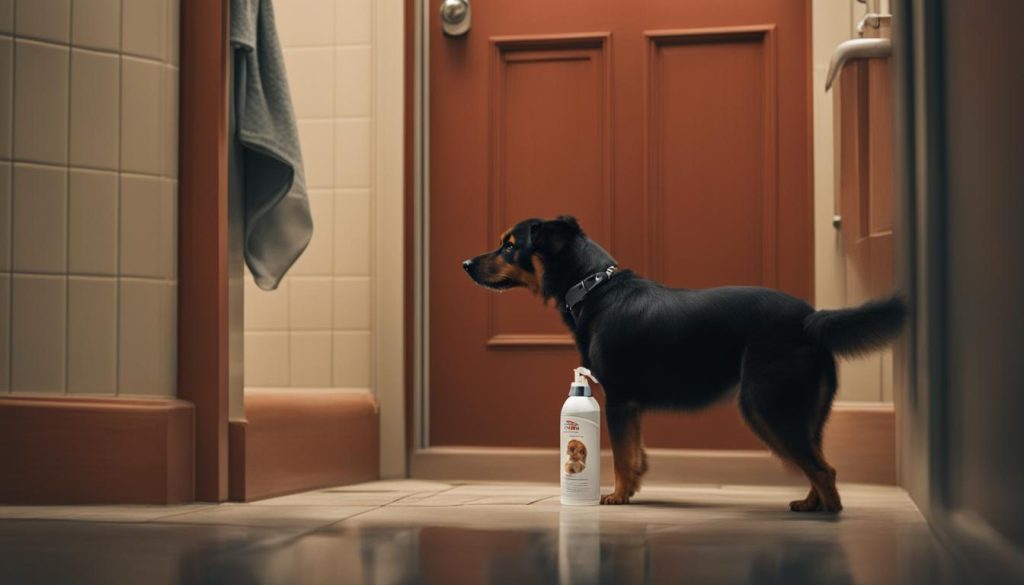
When it comes to addressing unwanted behavior in dogs, it’s important to approach it with patience, consistency, and positive reinforcement. Here are some strategies to help modify and prevent unwanted dog behavior:
- Identify the underlying cause: Understanding the root cause of the unwanted behavior is crucial for effective modification. Whether it’s separation anxiety, fear, or a lack of proper training, identifying the cause will guide your approach.
- Consistency is key: Establishing clear rules and boundaries and consistently enforcing them will help your dog understand what is expected of them. Avoid reinforcing the unwanted behavior by consistently redirecting their attention to more appropriate activities.
- Positive reinforcement: Reward your dog for exhibiting desired behaviors. Use treats, praise, and affection to reinforce good behavior, encouraging them to repeat it.
- Redirect and distract: If your dog engages in unwanted behavior, redirect their attention to a more appropriate activity or toy. By providing them with an alternative outlet for their energy or excitement, you can discourage the unwanted behavior.
Remember, punishment and negative reinforcement are not effective or humane methods for addressing unwanted behavior. Instead, focus on positive reinforcement and redirection to help your dog learn and develop more desirable habits.
Consulting with a professional dog trainer or behaviorist can be invaluable when addressing complex or persistent unwanted behavior. They can provide customized guidance and techniques tailored to your dog’s specific needs, ensuring the most effective approach.
Summary
Addressing unwanted behavior in dogs requires a thoughtful and consistent approach. By understanding the underlying causes and utilizing positive reinforcement and redirection techniques, you can modify and prevent undesirable behaviors. Remember to be patient and seek professional guidance when needed to ensure a healthy and harmonious relationship with your canine companion.
Tips for Dog Owners
As a dog owner, it’s important to have a clear understanding of your dog’s behavior and how to manage it effectively. By following these tips, you can strengthen the bond between you and your four-legged friend while promoting a harmonious dog-owner relationship.
1. Provide Regular Exercise and Mental Stimulation
Regular exercise is essential for keeping your dog physically fit and mentally stimulated. Engage in activities such as daily walks, playtime, or interactive toys to keep them engaged and fulfilled. This not only helps to prevent boredom but also promotes overall well-being and helps to curb any excess energy that may contribute to unwanted behaviors.
2. Establish Consistent Routines
Creating consistent routines provides a sense of security for your dog. Establish regular mealtimes, exercise routines, and sleeping schedules. Dogs thrive on structure and predictability, and having a consistent routine can help them feel safe and secure in their environment. Consistency also promotes good behavior by reinforcing positive habits and reducing anxiety or stress-related behaviors.
3. Set Clear Boundaries and Reinforce Positive Behaviors
Setting clear boundaries is crucial in managing your dog’s behavior. Clearly communicate what behaviors are acceptable and reward your dog with praise, treats, or affection when they exhibit positive behaviors. Positive reinforcement helps to strengthen the desired behaviors and encourages your dog to continue behaving appropriately. It’s important to be consistent in your training methods and avoid using punishment or negative reinforcement, as these can have adverse effects on your dog’s behavior and well-being.
4. Seek Professional Help if Needed
If you encounter any concerning or challenging behaviors in your dog, don’t hesitate to seek professional help. A certified dog trainer or behaviorist can provide guidance tailored to your dog’s specific needs. They can help you identify the underlying causes of unwanted behaviors and develop a customized behavior modification plan. Professional assistance can make a significant difference in addressing and managing any behavioral issues, ensuring a happier and healthier dog-owner relationship.
Remember, being a responsible dog owner involves understanding and respecting your dog’s needs and behaviors. By incorporating these tips into your routine, you can create a strong and harmonious bond with your canine companion.
Wrapping Up
In conclusion, dogs following their owners to the bathroom is a common behavior rooted in their pack mentality and desire for companionship. This behavior is often attributed to factors such as animal instinct, positive reinforcement, and curiosity. Understanding why dogs exhibit this behavior can help dog owners foster a deeper connection and provide the necessary attention and care their dogs desire.
By considering the unique needs and behaviors of dogs, owners can create a harmonious and fulfilling relationship with their loyal companions. It is important to provide regular exercise and mental stimulation to keep dogs engaged and fulfilled. Additionally, establishing consistent routines and setting clear boundaries through reward-based training can contribute to a sense of security and balance.
Should dog owners encounter any concerning or challenging behaviors in their dogs, seeking professional help from a dog trainer or behaviorist is recommended. By understanding and respecting the needs and behaviors of dogs, owners can develop a strong and harmonious bond with their canine companions.
FAQ
Why do dogs follow you to the bathroom?
Dogs have a tendency to follow their owners everywhere, including the bathroom, due to their animal instinct and pack mentality. They may do this to protect a part of their pack and alleviate any feelings of vulnerability when their owners are out of sight.
What are the reasons dogs follow you to the bathroom?
Dogs may follow their owners to the bathroom for various reasons. One reason could be the positive reinforcement they receive, such as affection or treats. Curiosity is another reason, as dogs see their owners as gateways to all things wonderful and magical. Dogs may also view the bathroom as part of their home and feel the need to monitor their owners’ whereabouts within these boundaries.
What does it mean when dogs follow you to the bathroom?
Dogs view their owners as their primary source of love, comfort, and security. By following their owners to the bathroom, they are displaying their attachment and bonding to them. Dogs feel secure and safe when they are close to their owners and may find comfort in their presence. This behavior also stems from their pack mentality, as they see their owners as the leaders of their pack and want to be near them at all times.
Why do some dogs exhibit this behavior more than others?
Dogs are pack animals and have a strong instinct to be part of a group. Some dogs may exhibit the behavior of following their owners to the bathroom more than others due to their individual personalities and levels of attachment. Factors such as aging, illness, or fear may also influence the frequency or intensity of this behavior.
How can I address unwanted behavior of my dog following me to the bathroom?
To address unwanted behavior, it is important to provide consistent training, positive reinforcement, and set boundaries. Ignoring the behavior or providing negative reinforcement may inadvertently reinforce it. Seeking professional help from a dog trainer or behaviorist can also be beneficial in managing and modifying unwanted behaviors in dogs.


